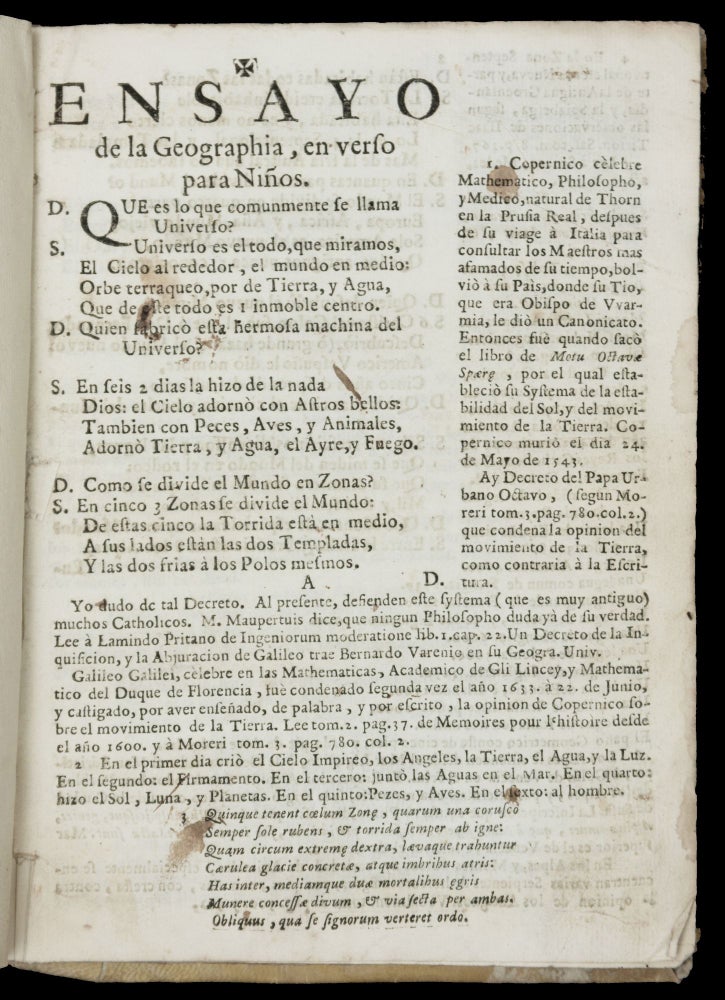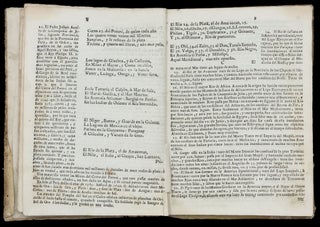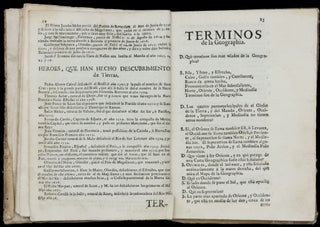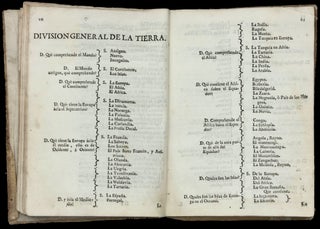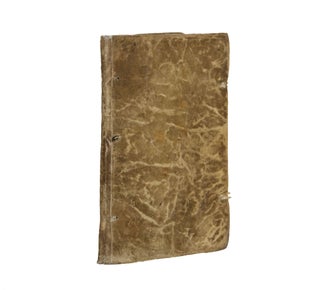Ensayo de la Geographia, en verso para Niños.
4to [20.0 x 14.5 cm], 80 pp. Bound in contemporary vellum, remnants of ties, ex libris of the Marqués de Pidal inside upper cover. Vellum a bit cockled and with some staining. Occasional minor staining internally, a few leaves slightly separating from sewing at lower inside edge but generally well connected otherwise, overall a bright, genuine, and well-preserved example. Extremely rare first and only edition of this unusual 18th-century Spanish work written to educate youths about geography and thus containing much information about Spanish and Portuguese colonial holdings in the Americas. We locate only one institutional copy worldwide (Biblioteca de Castilla y León) of this anonymously authored tract, which, judging by a list of Spanish Kings at page 66, was written during the reign of Ferdinand VI (1746-59). The book, in addition to covering more benign geographical topics, offers a fascinating look at the pedagogical and rhetorical methods used to teach (or indoctrinate) young students about the operation of the Spanish Empire in the Americas. Characterized by a curious mix of Enlightenment educational principles and older, more rote forms of learning (one suspects a Jesuit author), the book certainly merits further investigation. The work opens with a poem (pp. 1-12) which begins with the Creation, lists mountains, lakes and rivers (Andes, Rio de la Plata, Amazon, Mississippi), and concludes with a stanza on the Conquest led by Cortez and Pizzaro and the circumnavigation of the globe by Magellan and Elcano. This short poem is extensively footnoted with information on Copernicus, Galileo, Columbus, Vespucci, ancient and sacred history, etc. There follows a list of “heroes” who explored the New World (Cabral, Aubert, Ponce de Léon, Balboa, Cortez, Verrazano, Cartier, Pizarro, Del Norte, Le Mair, Marquette, De la Salle, etc.) (p. 12) and a list of questions-and-answers in prose about the terminology of geography and types of government (pp. 12-19). Next is a question-and-answer chart about divisions and subdivisions of global regions and countries (e.g. “Q: North America is comprised of what? A: New France, New England, ‘Nueva Provincia de Lore’, Virginia, Florida, New Mexico, Mexico”; “Q: Is there an island to the west” A: Yes, California (If it’s not a peninsula)” (pp. 20-24) and a list of global islands (large, medium, small, very small), peninsulas, isthmuses, promontories, capes, mountains, seas, oceans, gulfs, straits, with information on Cuba, Hispaniola, Jamaica, Puerto Rico, etc., and with an excursus about Eusebio Kino’s opinion that California is a peninsula (pp. 24-35). There follows a poem in question-and-answer form on European countries, capitals and populations (pp. 36-8), again extensively annotated. The longest section of the book is a poem in question-and-answer form (which sometimes devolves into prose lists) on Spain and its regions, size, economy, climate, flora and fauna, religion, armies and fleets, monarchy, government structures, bishoprics (and archbishoprics, etc.) in Spain and the Americas, universities, and towns and cities. Here the Americas are much discussed in both the verse itself and in the poem’s extensive apparatus of footnotes (silver at Potosí, the Consejo de las Indias, ecclesiastical organization from Cuba to Mexico to Chile and Argentina (pp. 39-64). Next is a short question-and-answer poem on Portugal (which concludes with a verse about the African slave trade and the importation of gold, silver, sugar and tobacco from Brazil) (pp. 65-6). The volume concludes with a list of the Kings of Spain, ancient names for Spanish regions and cities, and (rather oddly for a young person’s book), extensive tables about rents due from bishoprics, as well as tables giving a census of religious orders and societies in Spain (pp. 67-80). OCLC and KVK locate only the example at the Biblioteca de Castilla y León. * Collated against the Biblioteca de Castilla y León copy.
Sold

